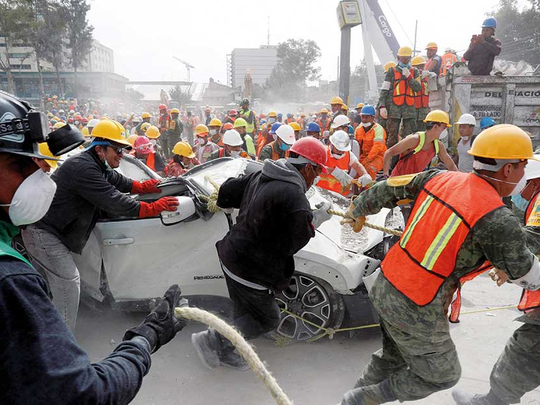
MEXICO CITY: Mexican rescuers worked through the night Saturday in a desperate last-ditch search for survivors of an earthquake that killed nearly 300 people, hoping to defy experts who say the chances of finding life in the rubble after 72 hours are bleak.
That 72-hour-mark beyond which hope is considered futile expired at 1:14pm (1814 GMT) Friday — the hour that the 7.1 earthquake struck on Tuesday.
Three days is the limit that experts say people trapped in rubble without water, often with crushed limbs, can hold on. Usually, the next phase is sending in bulldozers to clear away the debris and recover bodies.
But with Mexicans remembering “miracle” rescues a week following a worse quake in 1985 that killed 10,000 in the capital, and with anguished families refusing to cede to grief, President Enrique Pena Nieto promised officials would prolong their delicate probing for survivors.
“We have to keep up the rescue effort to keep finding survivors in the rubble,” he said on a visit to neighbouring Puebla state, also badly hit.
“No to machinery. Yes to hope,” read one handwritten sign outside a toppled building in Mexico City.
The open-ended extension posed a dilemma for rescue workers in the ruins of a Mexico City clothing factory, just one of 39 collapsed buildings in the capital.
Continue, but until when?
“There are no indications of anyone inside but they’re not sure enough to affirm there’s really no one. The camera used doesn’t allow a full view,” explained Daniel Quiroz, a 22-year-old volunteer.
In all likelihood, the death toll was going to rise above the latest figure of 291 given by the civil protection service.
Since the quake, 115 survivors have been plucked from the rubble, according to the Mexican military.
But the last successful rescues happened Thursday. On Friday, there were only bodies being recovered.
Mexico City recorded the highest number of fatalities: 153, with more bodies certain to be found in the mangled remains of 39 buildings that collapsed.
The rest of the deaths occurred in the nearby regions of Morelos, Mexico state, Puebla, Guerrero and Oaxaca.
In the capital’s trendy central neighbourhood of Roma, rescue workers were trying to locate several people in the wreckage of a collapsed seven-story office building.
They had pulled 28 survivors from the mountain of rubble in two days. But on Friday, despair was setting in.
“Since yesterday, they haven’t pulled anyone out,” wailed Xochitl Gonzalez, 39, cousin of one of those trapped. “We don’t believe them anymore. There are people decomposing in there.”
“There are probably around 50 people inside,” in what used to be an accounting office, said one woman who said she worked there. Others spoke of around two dozen trapped inside.
Anxious relatives kept vigil, their faces pallid. Some averted their gaze from the rubble. Tents set up for them were unslept in.
“Keep the faith,” a Spanish rescue worker urged the families waiting at the site.
A female firefighter, Teresa Ramirez, cousin of an accountant in the collapsed Roma building, said: “Thank God international experts have arrived.”
Several countries, including the United States, Israel, Panama and EU states have sent crews to help.
A Japanese emergency team was using a hi-tech scanner on the toppled building in the Roma district.
Jose Gutierrez, father of one of those trapped, and also a civil engineer helping with the rescue, warned that “the structure is at risk of total collapse.”
Overnight rain had caused saturated debris to become heavier and shift, he explained.
In the south of Mexico City, at a flattened school where 19 children died, white wreaths lay out, testimony to the mourning of relatives and neighbours.
The charity group Save the Children said 100,000 children in Mexico City were affected by the quake, with hundreds of them left to sleep in the streets and parks despite around 50 shelters being opened.
Many adults wondered where they and their families will live after the quake damaged more than 2,000 homes — most of which were not insured.
“I’m waiting for the civil protection service to tell me if we can go home or not,” said street vendor Erika Albarran, who has been staying with her family in a shelter for people with no place to go.
Her family has only 100 pesos ($5.50; Dh20) among them and she doesn’t know how they will manage once assistance such as food, shelter and baby supplies runs out.
“We don’t have cash. We’re living day to day,” she said.
Tuesday’s tragedy struck just two hours after Mexico held a national earthquake drill — as it does every year on the anniversary of the 1985 quake.












